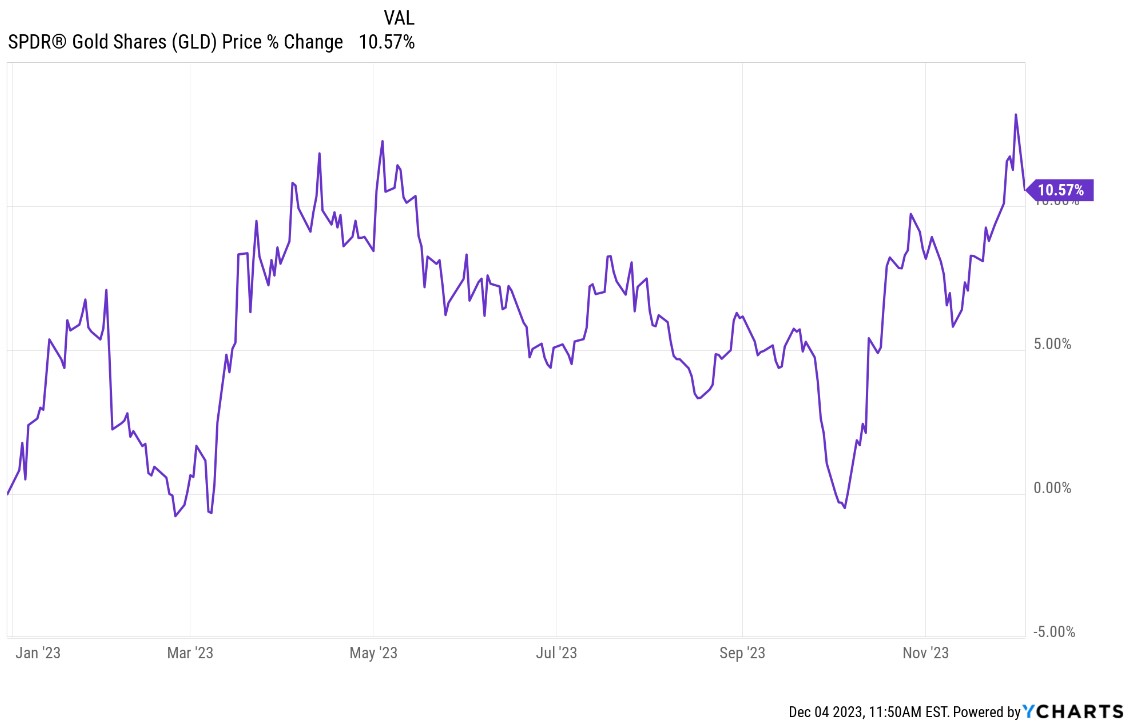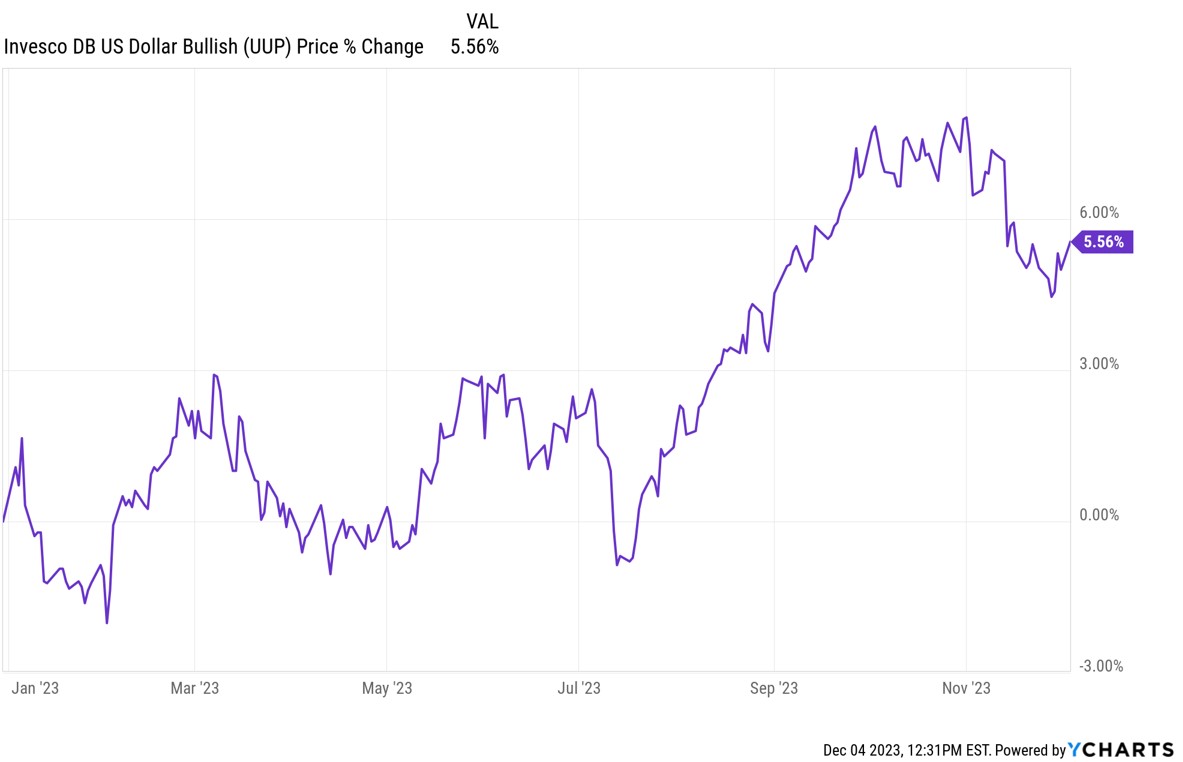Gold Investing: What's Next After Recent Gold Price Highs?
If you're hesitant about gold investing simply because prices have run up so much already, here are a few points to consider.


Karee Venema
Gold investing has become a hot topic on Wall Street these days. This is because gold prices (GOLD) recently hit new all-time highs.
The yellow metal has been trending sharply higher since early October and many are wondering if it can continue this momentum into the new year.
Year-to-date chart of the SPDR Gold Shares ETF (GLD)

Most gold is held in central bank vaults or held as jewelry, so the investable market for gold isn't exceptionally large. Take for instance these two gold ETFs: the SPDR Gold Shares (GLD) and the iShares Gold Trust (IAU). The former is the largest and most liquid gold ETF at $58 billion in assets under management (AUM), while the latter has just $26 billion in AUM.

Sign up for Kiplinger’s Free E-Newsletters
Profit and prosper with the best of expert advice on investing, taxes, retirement, personal finance and more - straight to your e-mail.
Profit and prosper with the best of expert advice - straight to your e-mail.
For perspective, the three largest S&P 500 Index ETFs have $1.2 trillion dollars in combined assets, and the market cap of the S&P 500 Index itself is around $38 trillion.
So those worried about investing in gold at new highs, take a little heart. Given the relatively small size of the investable gold market, it wouldn't take much in the way of new inflows to send the price of gold sharply higher from here.
But why is gold trending higher, and can it continue?
Gold investing: Why is the gold price trending higher?
Inflation. The Fed flooded the capital markets with virtually unlimited liquidity for nearly two full years during the pandemic, expanding its balance sheet by almost $5 trillion in the process.
This massive monetary stimulus – along with government assistance and a global supply chain that still isn't fully untangled – helped to push inflation to the highest levels in four decades. Consumer Price Index (CPI) inflation touched 9% in mid-2022.
Remember, gold is traditionally an inflation hedge. While its price is often volatile, gold has done a good job of maintaining purchasing power over the centuries. And while inflation is down from its highs, registering at 3.2% in the most recent report, it is still a long way from the Fed's target of 2%. All else equal, sticky inflation bodes well for gold.
But gold's rise is not exclusively an inflation phenomenon. If that were the case, we wouldn't have seen gold prices weaken in the summer of 2022, when inflation was the highest. There are other elements at play here.
The weak dollar. The U.S. dollar has been one of the world's stronger currencies over the past decade. The turmoil of the pandemic accelerated the dollar's rise, but that was only the beginning. As the Fed scaled back its asset purchases and started aggressively raising interest rates, the dollar soared to multi-decade highs against many world currencies, including the euro and British pound.
But more recently the dollar's strength has started to fade amid expectations the world's central banks have reached peak rates and will soon start to ease monetary policy.
You can see this in the performance of the Invesco DB US Dollar Index ETF (UUP), which tracks the performance of the dollar against a basket of major world currencies.
Year-to-date chart of the Invesco DB US Dollar Index ETF (UUP)

Gold's rise started the same time that the dollar's strength started to fade. That's no coincidence. Gold is priced in dollars, so dollar weakness is, by definition, gold strength.
The U.S. dollar has a history of trending higher versus other major world currencies for years or even decades at a time, but these periods of strength are generally followed by comparable stretches of dollar weakness. We may be in the early stages of one of those stretches … and that's bullish for gold.
Geopolitical risk. Gold is often seen as a safe-haven asset class during times of uncertainty. The recent turmoil in the Middle East and the ongoing war between Russia and Ukraine likely contribute to investors seeking out the yellow metal.
"The reason the price [of gold] can move in different directions is because when things become uncertain in stock markets, investors sell shares and want to buy something with a value that's considered 'safer,'" says Hal Cook, senior investment analyst at Hargreaves Lansdown. Gold, in particular is a popular choice "because it's recognized globally as something of value," the analyst notes, adding that "it can be a useful diversifier in a portfolio, particularly during periods of market stress."
And Cook says that "while the potential for the Israel – Hamas conflict to escalate further may have reduced more recently, fundamentally geopolitical risks are higher now than they were six weeks ago."
Related content
Get Kiplinger Today newsletter — free
Profit and prosper with the best of Kiplinger's advice on investing, taxes, retirement, personal finance and much more. Delivered daily. Enter your email in the box and click Sign Me Up.

Charles Lewis Sizemore, CFA is the Chief Investment Officer of Sizemore Capital Management LLC, a registered investment advisor based in Dallas, Texas, where he specializes in dividend-focused portfolios and in building alternative allocations with minimal correlation to the stock market.
- Karee VenemaSenior Investing Editor, Kiplinger.com
-
 6 Stunning Waterfront Homes for Sale Around the US
6 Stunning Waterfront Homes for Sale Around the USFrom private peninsulas to lakes, bayous and beyond, Kiplinger's "Listed" series brings you another selection of dream homes for sale on the waterfront.
By Charlotte Gorbold Published
-
 Six Reasons to Disinherit Someone and How to Do It
Six Reasons to Disinherit Someone and How to Do ItWhether you're navigating a second marriage, dealing with an estranged relative or leaving your assets to charity, there are reasons to disinherit someone. Here's how.
By Donna LeValley Published
-
 CPI Report Puts the Kibosh on Rate Cuts: What the Experts Are Saying About Inflation
CPI Report Puts the Kibosh on Rate Cuts: What the Experts Are Saying About InflationCPI Consumer price inflation reared its ugly head to start the year, dashing hopes for the Fed to lower borrowing costs anytime soon.
By Dan Burrows Published
-
 Fed Leaves Rates Unchanged: What the Experts Are Saying
Fed Leaves Rates Unchanged: What the Experts Are SayingFederal Reserve As widely expected, the Federal Open Market Committee took a 'wait-and-see' approach toward borrowing costs.
By Dan Burrows Published
-
 CPI Report Keeps the Fed on Track: What the Experts Are Saying About Inflation
CPI Report Keeps the Fed on Track: What the Experts Are Saying About InflationCPI Disinflation in key areas of consumer prices should help the Federal Reserve stick to its policy path of gradual cuts to interest rates.
By Dan Burrows Published
-
 Blowout December Jobs Report Puts Rate Cuts on Ice: What the Experts Are Saying
Blowout December Jobs Report Puts Rate Cuts on Ice: What the Experts Are SayingJobs Report The strongest surge in hiring since March keeps the Fed on hold for now.
By Dan Burrows Published
-
 The Cheapest Places To Retire in the US
The Cheapest Places To Retire in the USWhen you're trying to balance a fixed income with an enjoyable retirement, cost of living is a crucial factor to consider.
By Stacy Rapacon Published
-
 Fed Sees Fewer Rate Cuts in 2025: What the Experts Are Saying
Fed Sees Fewer Rate Cuts in 2025: What the Experts Are SayingFederal Reserve The Federal Reserve cut interest rates as expected, but the future path of borrowing costs became more opaque.
By Dan Burrows Published
-
 CPI Report Casts Doubt on Rate Cuts in 2025: What the Experts Are Saying About Inflation
CPI Report Casts Doubt on Rate Cuts in 2025: What the Experts Are Saying About InflationCPI November Consumer Price Index data sealed the deal for a December rate cut, but the outlook for next year is less certain.
By Dan Burrows Published
-
 Rebound in Jobs Growth Keeps Fed on Track: What the Experts Are Saying
Rebound in Jobs Growth Keeps Fed on Track: What the Experts Are SayingJobs Report No nasty surprises in the November payrolls data leaves a quarter-point cut in play.
By Dan Burrows Published